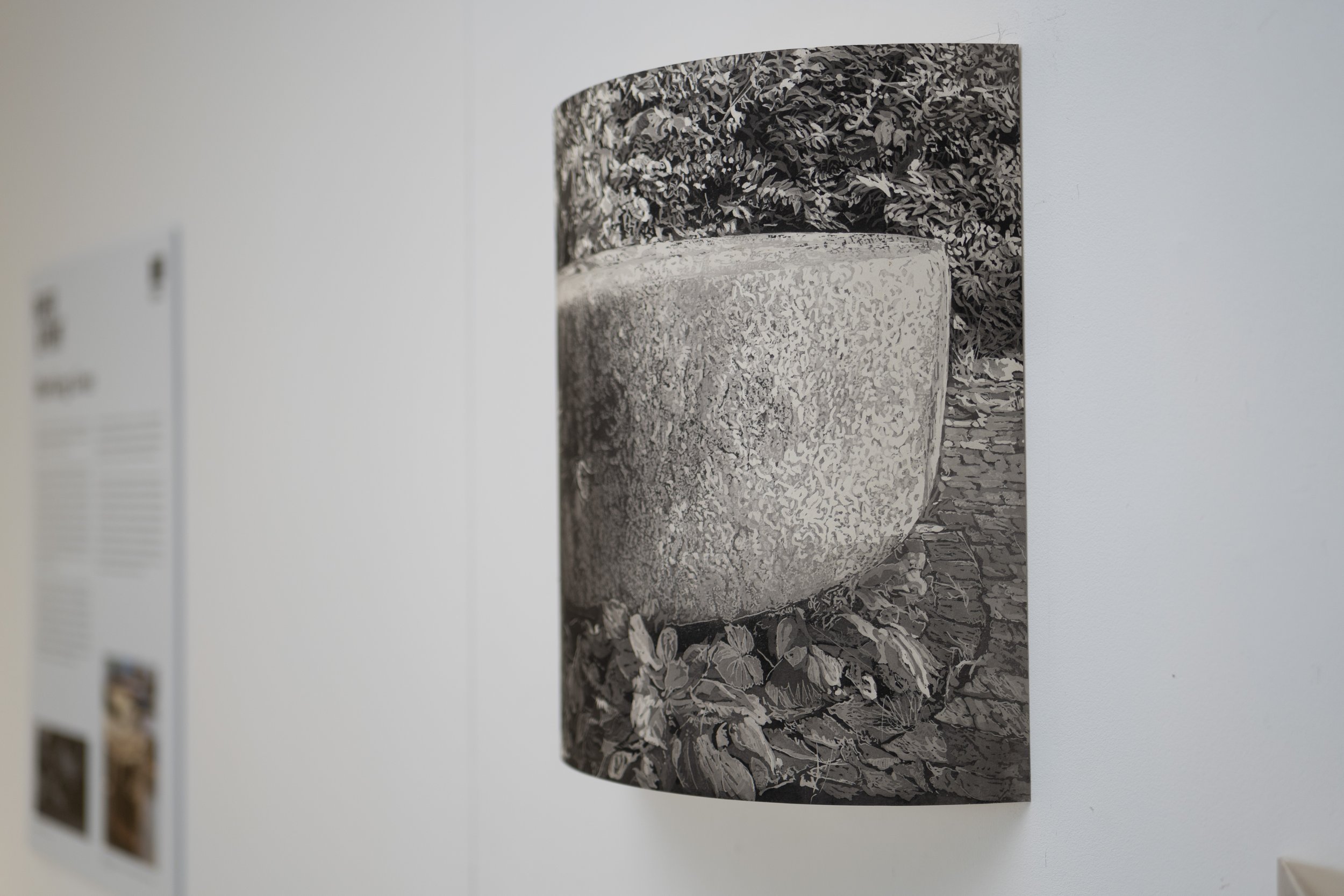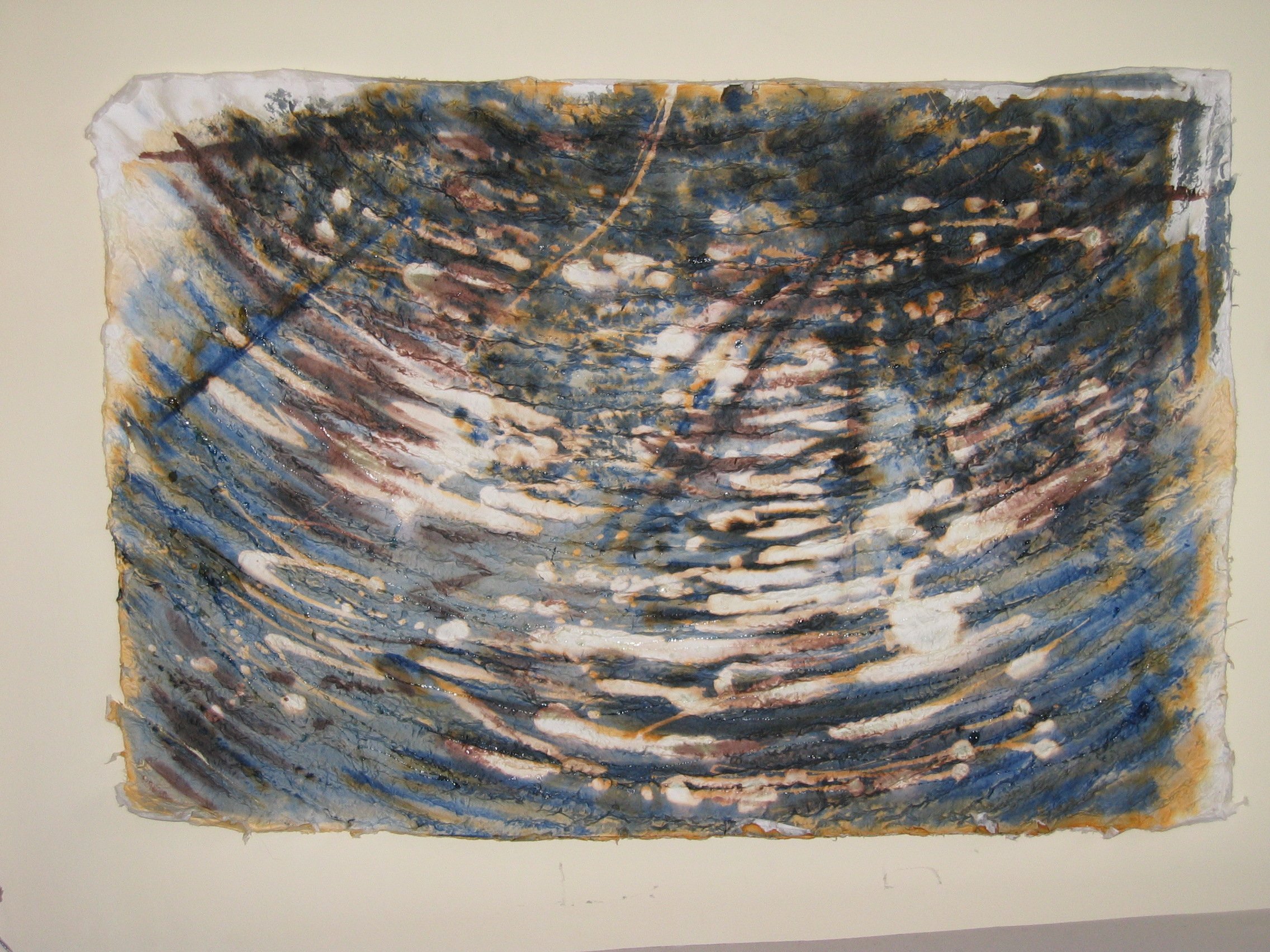Paper and Print: Exploring the history of paper making in Exeter
Paper and Print was a year-long community research project into Exeter’s paper mills. An exhibition at Positive Light Projects in Exeter marked the culmination of the project which was been run by Double Elephant Print Workshop in partnership with Prof Nicola Thomas, Head of Geography at the University of Exeter, and funded by The National Lottery Heritage Fund.
Working with a team of volunteer community researchers, they pieced together stories of the people working in the mills. A team of 15 researchers visited former mill sites in Exeter and along the Exe and Culm rivers. They talked to residents, descendants of mill owners and former paper mill workers. They collected memories, oral histories and undertook archive research in the Devon Heritage Centre, Exeter Cathedral Library & Archives and The Devon and Exeter Institution.
The research uncovered stories of child apprentices learning their trade, the journeying paper-makers travelling between mills, the workers who lost their lives in mill fires, the rag pickers living in the west quarter of Exeter, and those who came to Exeter from India to learn the trade. This evidence of the people who worked in the mills is part of the less visible history of Exeter’s paper industry.
As part of the project, local families and schools took part in papermaking workshops and events. To deliver the sessions, Double Elephant partnered with Devon Wildlife Trust, who now manage some of the former mill sites.








Two new artworks were commissioned in response to the research:
My installation Vestigia was one of two new artworks commissioned through consultation with the community researchers and is a composite installation created with paper embossed linocuts. The title comes from the Latin for “footprints or traces”, and is intended to suggest the way in which we now encounter the buildings and defunct machinery that once comprised Exeter’s paper mills. Many of these structures are hidden and may be discovered along walking routes once trodden by former mill workers. The use of embossing is intended to encourage tactile engagement with paper surfaces, and inspired inclusive printmaking workshops in which participants created responses to the work. The other artwork was a sound story by Ellen Wiles, imagining the life of a young female mill worker.
A parallel exhibition at the University of Exeter showcased the volunteers’ research, an overview of the community workshops, the illustrated Story Map, Ellen Wiles’ sound story and five of my blind embossed prints.












Images C/o Jim Wileman
Creative Interactions - Creativity, Creative Arts, and Neurodivergence Conference
Dates
Thursday, June 19, 2025 - 14:00 to Saturday, June 21, 2025 - 18:00
Book here
Saturday, June 21
9:30 AM: Registration
9.45 AM – 10.30 AM: Keynote by Chelsey Flood
10:30 – 11:30: Session 6: Creative Practice
- The Installation Drawing as Attention Tunnel: Exploring an Inclusive form of Immersion by Juliette Losq
- Time Travel, Flow and Wandering within Neurodivergent Creative Practice by Martina Cleary
[Chair: Sam Meekings]
Location
Foundling Museum, London
The Creative Interactions Research Group (Open University) explores the powerful intersections between academic research and creative practice. Disciplines across the arts and humanities have natural affinities with art forms such as creative writing, music, theatre, and fine art; indeed, many colleagues in the school are both academics and creative practitioners. Other colleagues, too, in social sciences and STEM subjects, engage with creative methods in research, engagement and impact. The group explores the ways in which engagement with creative practice can enhance academic research, and vice versa; they seek to open up new avenues and opportunities for what it means to do ‘academic research’ and what ‘research outputs’ should look like; and advocate for making collaboration with creative practitioners more accessible and easier in practical terms within existing structures for funding and administrating research.
Recent research on neurodivergence and creativity posits that persons with neurodiverse traits have heightened access to creative thinking. Conversations among researchers suggest that having a divergent mind might lead to divergent thinking, or ‘thinking outside the box,’ which is a strength for anyone in a creative field. What do creative practitioners and teachers have to say about the connections between neurodivergence and creative arts? How do creative practitioners and teachers engage with neurodivergence, whether their own or that of their audience or students?
Juliette Losq: Making a ‘Sanctorium’ for The Secret Garden
During 2020 and 2021, I worked with the Garden Museum on a commission for their exhibition The Secret Garden, 5 August – 1 November 2022, which explored Frances Hodgson Burnett’s book by the same title. They commissioned me to produce a large installation that explored contemporary ideas of secret gardens, urban abandoned spaces and nature reclaiming industrial spaces. The exhibition was the second in a series of exhibitions that the museum developed to engage family visitors with the Garden Museum’s exhibition programme.
“This was an audience that did not traditionally engage with the museum’s exhibitions. The exhibition theme was also selected to encourage intergenerational experiences amongst families.
Losq responded to our project brief and created a large immersive installation with built elements that represented a disused boat yard and painted elements that explored the interplay between abandoned land and plants reclaiming the space. The scale of the piece meant that families could explore it together, and wheelchair users could also engage with the piece. The piece was one of the highlights of the exhibition, with visitors spending time exploring the piece in detail.
Losq’s clear and precise way of working with maquette models and her clear vision for the installation enabled our learning and public programme team to envision the work before it was installed and develop their programmes around it. They developed a huge number of events, but perhaps the most satisfying one was a collaboration with the Evelyna Hospital, where children were able to make their own shoebox gardens whilst in hospital.” Emma House, Curator, Garden Museum




Images c/o The Garden Musem
Umbraclum at Sewerby Hall and Gardens
This Arts Council funded commission, intended to promote contemporary art to new audience was a part of the East Riding Visual Arts Uplift’s commitment to showcasing and integrating contemporary art into the region. Umbraculum is a large-scale, walkthrough, ink and watercolour on paper installation. Its layered form is inspired by the Telorama or paper peepshow, an eighteenth and nineteenth century optical device and parlour entertainment, whilst also referencing the pergola found in the gardens of Sewerby Hall. The drawn and painted imagery imagines the gardens at a future stage of ruination, with their formal, cultivated structures being reclaimed by nature.
“ Sewerby Hall hosted Juliette Losq's work entitled Umbraculum over the summer season 2021. It was a walk-through pergola installation of fine ink drawings redolent with motifs specific to Sewerby Hall and Gardens supported by a rigid built in situ framework. Umbraculum was well-received and popular with visitors, particularly families.” Janice Smith, Curator, Sewerby Hall
“Visitors can immerse themselves in this layered paper-based installation, which draws inspiration from the gardens and heritage of Sewerby Hall and Gardens. Juliette’s approach of watercolour and ink on paper captures the curiosity of viewers to explore the details hidden in the installation.” Scarbourough Evening News
The installation was accompanied by a programme of events including free artists’ talks and a literacy competition for young people.
Good Times and Prescription for Art Workshops, Dulwich Picture Gallery
As a Teaching Artist at Dulwich Picture Gallery, I delivered several workshops as part of the Good Times initiative and its offshoot, Prescription for Art, which reaches isolated elderly individuals by partnering with local doctors’ surgeries. The programme works by GPs and Nurses ‘referring’ patients to the Gallery to take part in creative workshops. The programme has been running for several years and has proven to enhance lives, combat isolation and create a new social life.
“Despite relying entirely on donations and grant funding, the gallery, which was founded in 1811, has been involved with outreach programmes for 20 years. In 2005 it launched its older people's programme, Good Times, partnering with 65 organisations to take art workshops into the community. Developed in collaboration with GP practices, the Prescription for Art offshoot connects with residents who may be frail, lonely or busy caring for loved ones, but do not attend regular pensioners' or community groups. Surgeries and, more recently, the memory clinic at Kings College hospital – can refer patients for free creative stimulation at its art workshops. The programme is so successful that it now has its own co-ordinator, a team of volunteer helpers and a rota of artists. Sessions, attended by up to 20 participants at a time, have included silk painting, lino printing, glass painting, sketching and clay work. Wide brushes are used for those whose eyesight may no longer be sharp and large brushes suit arthritic hands that find it difficult to grip smaller tools.” The Guardian Newspaper
As part of this I delivered sessions at Mission Care Elmwood, Shirley Methodist, Stockwell Day Centre and Prince George Duke of Kent Care Home as well as at the gallery. These watercolour and ink workshops were themed around the gallery’s programme of exhibitions including An American in London: Whistler and the Thames and From the Forest to the Sea: Emily Carr in British Columbia







